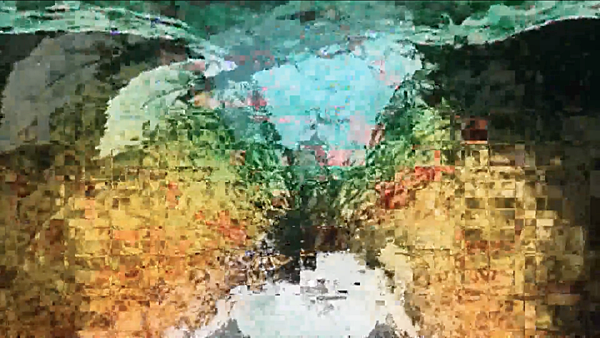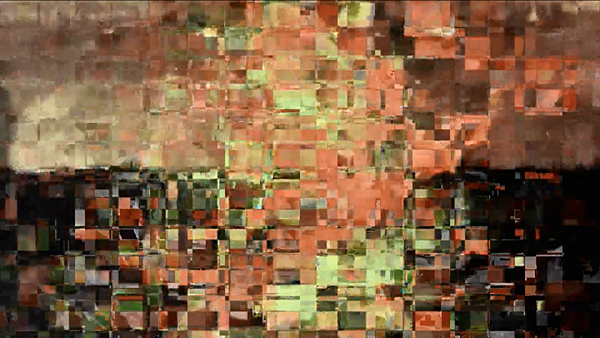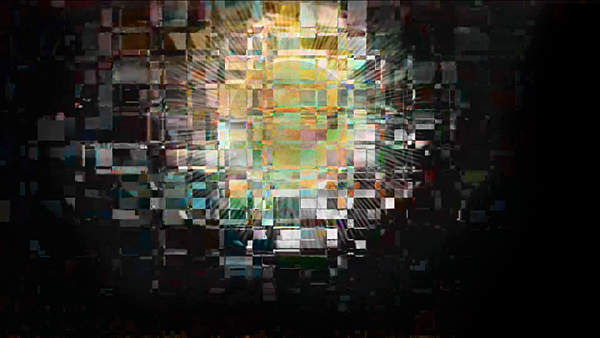from Cinegraphic.net:
Glitch Procedures in Helios | Divine (2013)
story © internetted, December 3, 2015 all rights reserved.
URL: https://www.cinegraphic.net/article.php?story=20151126143318425
The music video produced for Sa’eed Ali’s song of the same title, Helios | Divine is 4 minutes long, organized into four sections of approximately equal length. It is designed to act as a “posthuman landscape” where what we believe we see is not entirely the same as what is actually visible on screen: a complex network of squares and rectangles that ‘twinkle’ and contain a continually shifting field of colors that combine into larger blocks only to break into smaller, more discrete units. The imagery presented is emergent—what can be seen when looking at a still image is radically different than the encounter with the movie—but is also composed from uniform squares of color, an effect of the glitching process that stripped recognizable, high definition imagery from the “raw” footage. This visual development follows the sequence of imagery common to the revelatory experiences described in the 1930s by German psychologist Heinrich Klüver. A summary of his imagery describes the progression of Helios | Divine: in a continuously transforming shot (rather than a series of individual, discrete shots), the initial ‘parting of the veil,’ becomes by degrees a beautiful landscape, then a figure that merges into a large, circular disk with light rays stretching out, followed by a second, darker landscape.

Unlike my other visual music movies, such as Antag|Protag (2012) or One (2010) or my earlier music videos for the band The Poison Arrows (Casual Wave, 2008 and An Unexploded Dream, 2009) Helios | Divine runs as an evolution of what appears to be a single long take, denying visible editing to create a continuous flow. This effect was produced using the automated “time displacement” visual effects filter in Adobe AfterEffects. This software combines pixels drawn from frames taken at different points along the video’s timeline into a single frame. For this video I created a complex grid of black, white and grey squares that this effect would interpret as blocks, when rendered this design created in an all-over composition resembling abstract painting in motion. The visuals to be in a state of continuous transformation until they finally end, blacking out a block at a time over a 5 second period.
The finished movie is composed from several pieces of archival footage: (1) a sixty second shot of Loďe Fuller performing her serpentine dance in vue Lumière no. 765, Danse Serpentine (1896), the same foundational material used in my earlier movie Dancing Glitch also from 2013; (2) a short clip of an burlesque dancer from the 1940s; (3) a still image of a sun with rays; (4) a short NASA/JPL movie running 6 seconds of the Sun seen in infrared. Only (2) the burlesque dancer appears as a coherent, recognizable form—the ghostly dancer whose blurred outline appears on screen for less than 15 seconds. The “Sun” appears as a circle around which a graphic of solar rays spin—the only indication (other than the title) that this form is the Sun. All of this material is subordinated to the complex grid of colored boxes that create the dominant graphic ‘shape’ of the on-screen imagery (they are simply modifications to the grid of boxes).
There are two levels of synchronization in the finished movie. The first is a low level sync to individual notes, created by a simple piece of databending the base grid compressed in H.264. I changed a single hexadecimal value pair, ( to ), producing a glitched video that Adobe AfterEffects was able to parse and render. It was recompressed and edited with Adobe Premiere so the video break-up would synchronize with glitch sounds in the music, and imported back into AfterEffects.

The other level of sync is to the four distinct sections of the music. This complex synchronization required several individual phases of planning and preparation so the visuals would remain synchronized after being distorted via “datamoshing,” a ‘glitch’ technique that selectively removes part of the video’s data, leaving behind only those parts of the image that are in motion—the fine details are lost in this process, giving the movie a consistent, pixelated appearance, effectively transforming a high resolution source into a blocky, abstract grid of uniform sharpness and detail, which became the foundation for the actual construction of the final piece.
Helios | Divine employs several distinct glitch techniques in the generation of its imagery. My use of a glitched datastream resulting in an aberrant video playback (decompression) is a common feature of the glitch technique called “databending.” The resulting glitches are a result of ‘faulty’ compression-decompression that generates graphic forms as a result of discrepancies within the file’s data. The goal with this design was the generation of a visual field in motion that relates to the abstract paintings of Chuck Close and Gustav Klimt—the initial “raw” source material had the necessary visual character (a break up into the grid of colored boxes) but still retained a recognizable character; one of the other side effects of the displacement effect was differences in resolution: some parts of the image were sharply defined, while others had become unfocused. My use of both databending and the process called “datamoshing” that removed the high-resolution image data from the video file, was specifically to change the visual character of this footage so it would have a singular, uniform resolution. In the process, the macroblocks and break up of the image into discrete colored blocks became visible.
All the compositing in the final movie balances between suggesting representational and abstract imagery. Using automated processes required a series of tests and experiments to get the timing of the final work “right.” The result is distinctly ‘post-human’ in its implementation: it draws attention to our interpretations of what we see, rather than simply presenting an image ‘as such’ for our consideration. This alignment of perception and immediate visual content mirrors the concern with ‘visionary’ form that structures this development: the sequence of imagery implies a hallucinatory experience, suggesting that the act of watching the movie and recognizing imagery in it may be related to these otherwise abnormal experiences, a contingency that draws attention to these interpretations as such.

Unlike my earlier movie that also features a ‘solar disk,’ Star Fish where the Sun appears as a destructive force linked to the visual glitches, in Helios | Divine, even though it is one of the only clearly defined images, its meaning is ambiguous—transcendence and destruction are equal potentials—the difference between one and the other simply an issue of context rather than an absolute value. This necessary context is absent, replaced by the ambivalence created by continuous transformation: it is possible to see this Sun as being both destructive (the screen visibly darkens as it appears) and transcendent or sublime. It is the uncertainty of which interpretation is correct that makes the contingency apparent, their coincidence and the contradiction they imply is the meaning.